The Desktop Kabini Review Part 1: AMD Athlon 5350 (AM1) Tested
by Ian Cutress on April 9, 2014 8:00 AM EST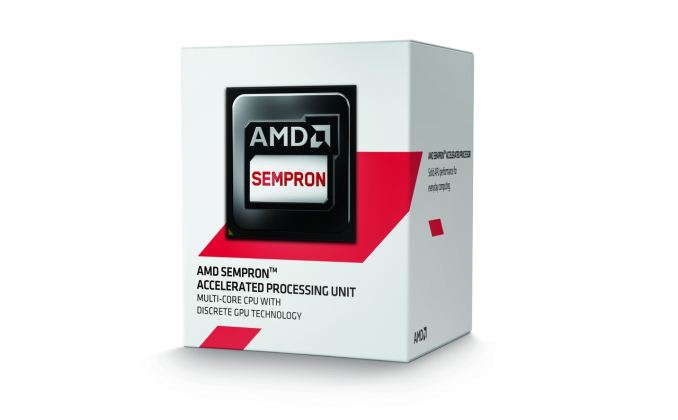
AMD announced earlier in March that it would be launching a socketed desktop Kabini APU. Traditionally the ultra low end/low power SoCs on desktops have come in packages soldered on to motherboards. If you need a faster CPU, you bought a new motherboard with it. With its new AM1 platform, AMD hopes to bring the sort of flexibility enjoyed by the rest of the desktop market to the entry level value segment.
The rationale is simple: the traditional desktop PC is under tremendous price pressure due to the popularity of affordable tablets, notebooks, Chromebooks and Chromeboxes. While there are definitely advantages to a desktop, it's a market that won't grow on its own. The one advantage desktops have over any of the aforementioned modern mainstream computing devices is upgradability. Unfortunately that's a feature that's often lost as we look at the value segment of the desktop market. AM1 attempts to fix that.
A socketed APU is useless without a lineup of APUs to swap in and out of the aforementioned socket, and that's exactly what AMD is launching today. There are a total of four AM1 APUs launching today:
| AMD AM1 Kabini APUs | ||||
|
Athlon 5350 |
Athlon 5150 |
Sempron 3850 |
Sempron 2650 |
|
| CPU Cores | 4 | 4 | 4 | 2 |
| CPU Frequency | 2.05 GHz | 1.60 GHz | 1.30 GHz | 1.45 GHz |
| GPU Cores | 128 | 128 | 128 | 128 |
| GPU Frequency | 600 MHz | 600 MHz | 450 MHz | 400 MHz |
| Memory Frequency | 1600 MHz | 1600 MHz | 1600 MHz | 1333 MHz |
| L2 Cache | 2 MB | 2 MB | 2 MB | 1 MB |
| TDP | 25 W | 25 W | 25 W | 25 W |
| Price | $55 | $45 | $36 | $31 |
Each of these APUs features up to four 28nm Jaguar cores and a 128 SP implementation of AMD's GCN GPU. We've gone over both the Jaguar and GCN architectures in previous articles, so we won't spend a lot of time recapping them here. Jaguar is the latest in AMD's line of "cat" cores, designed to go up against Intel's Atom. GCN on the other hand is a well known GPU design from AMD as well, cut down here to fit in a much smaller die area (and thermal envelope).
This isn't the first time we've seen this Jaguar + GCN combination of course. Kabini first launched as a notebook APU nearly a year ago. Architecturally we're looking at the very same SoC, even down to running at the same max clocks and at the same TDP. The big difference is what we have here today is socketed and targeted at the desktop.
The Athlon and Sempron brands are back and used for AM1 Kabini. The most expensive AM1 APU is the $55 Athlon 5350, a quad core SoC running at 2.05 GHz with a 2 compute unit GCN GPU (128 SP) running at 600 MHz. All four models will have an official TDP rating of 25W, suggesting that they are all the same die and merely binned according to performance.
While the APU costs are low, it's actually the motherboard costs that are most impressive. AMD expects mini-ITX and micro-ATX AM1 motherboards to retail for between $25 - $35. At the low end of the spectrum that means you could be looking at a fully integrated desktop platform for less than $60. Obviously you have to add in the cost of memory, storage, PSU/chassis and heatsink/fan but we're still dealing with an extremely low cost solution.
The real value in having a socketed processor is being able to upgrade the chip without incurring the cost of a new motherboard down the road. Unfortunately AMD isn't saying anything about what future APUs will support Socket-FS1b, so for now all we have is what's in the table above. Given the BGA compatibility between Kabini and Beema, I'd assume we might see a Beema FS1b upgrade at some point. However what comes after that remains to be seen.
Historically AMD has done a good job of maintaining backwards compatibility with sockets for as long as possible, the one challenge being shifts in memory technology. With DDR4 expected to ship at the high end later this year, the DDR3 based FS1b platform should at least have some life in it from a memory compatibility standpoint.
The Platform, Socket & Motherboards
While AM1 is the name of the platform, FS1b is the name of the new socket. AMD sent along a Gigabyte AM1 micro-ATX board (the GA-AM1M-S2H):
The AM1 platform makes for incredibly simple motherboards. There's hardly anything down on the board itself as Kabini is a full blown SoC with integrated memory, PCIe, USB, Gigabit Ethernet and SATA controllers. Gigabyte threw down an iTE Super I/O chip on the motherboard (beneath the heatsink in the lower left) to add serial, LPT, and PS/2 keyboard/mouse ports.
The key points to note here are:
- Single Channel 64-bit DDR3/DDR3L
- Two USB 3.0
- Eight USB 2.0
- PS/2
- Trusted Platform Module Support
- Up to four eDP/DP/HDMI video ouputs
- VGA output
- Four PCIe 2.0 lanes for a discrete GPU/PCIe device
- Two SATA 6 Gbps ports
- One PCIe 2.0 x1 lane allocated to an Ethernet controller
- Three PCIe 2.0 x1 lanes for other controllers (SATA, USB, LAN, WiFi, PCIe 2.0 x1 slots, PCIe to PCI bridges)
As you can see, Kabini provides a good amount of IO. The Gigabyte board includes a single PCIe x16 slot (x4 electrical) and two x1s. You also get two USB 3.0 ports and two USB 2.0 ports on the back header, although the APU itself can support up to 8 USB 2.0 ports. There are also two 6Gbps SATA ports down on the board, the maximum supported by Kabini.
The audio solution has to be cheap to be viable, and we get an ALC887 Realtek codec, which is actually higher end than I expected. Realtek are said to offer a discount when an audio codec and network controller are bought for the same product, so it is no surprise to see a Realtek NIC equipped here.
Because AM1 is a drive to low cost platforms, I do not see many motherboard manufacturers taking advantage and producing works of electrical engineering art. When the most expensive APU you can purchase for a platform is $55, when a motherboard manufacturer starts considering extra controllers or fancy features, the cost/benefit analysis might go out of the window. An extra USB 3.0 controller might add $0.75 to the bill-of-materials, require extra validation and optimization, then add a final $2.50 to the end-user cost (or $4 after retailer markup). After speaking with Patrick from ServeTheHome about the platform, there is certainly scope for adding several NICs to the motherboard and combining its use both as a PC and a router, however none of the motherboards being released with AM1 at launch seem to have more than one.
I was told by AMD that AM1 systems should support memory overclocking above the verified DDR3-1600 speed. This should allow the integrated graphics to stretch its legs a bit more despite the presence of a single channel memory controller should a system integrator consider buying faster memory. Unfortunately at least the Athlon 5350 seems locked to a max multiplier of 20.5x, so there's no hope for easy overclocking of this part at least.
On day one, motherboards should be available from the following vendors:
Once the products are in the market we will attempt to go over them all in one of our motherboard previews, and perhaps a few in full reviews.
With a new socket comes a new heatsink mounting system. Although the rest of AMD's desktop sockets still rely on a latch + lever retention system, Socket-FS1b moves to a push-pin design similar to what Intel uses on its motherboards (albeit with fewer mounting holes, and much simpler mounting/removing due to lower retention force requirements).
At 25W TDP, we might have been hoping for a passive solution, and I am sure that one of the CPU cooler manufacturers will make one, but AMD is playing it safe by using a small active low profile stock cooler. I would hazard a guess that this is an all aluminium construction in order to keep costs down. The reference AM1 HSF is oddly reminiscent of what old "high end" CPUs used to use years ago.
Most AM1 platform motherboards will be similar to what we have here. Some will ship with DisplayPort/DVI, and others might have an extra USB3/SATA controller. I doubt we will see any with audio codecs above the ALC892, or Killer NICs, although there might be an Atheros in the mix.


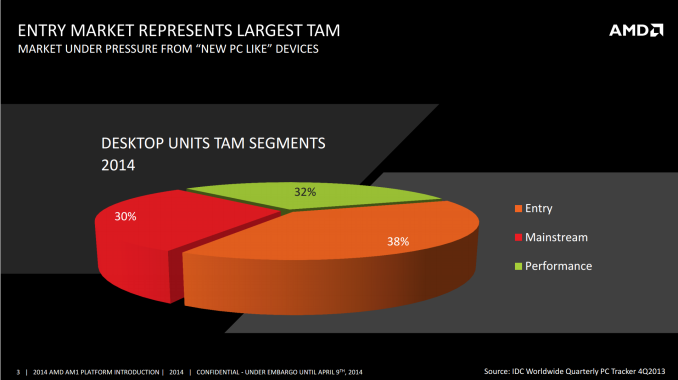
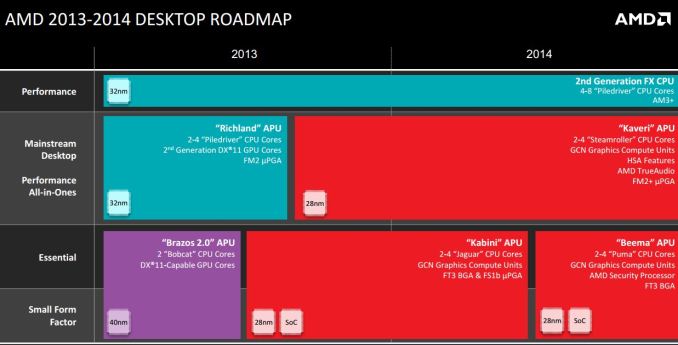







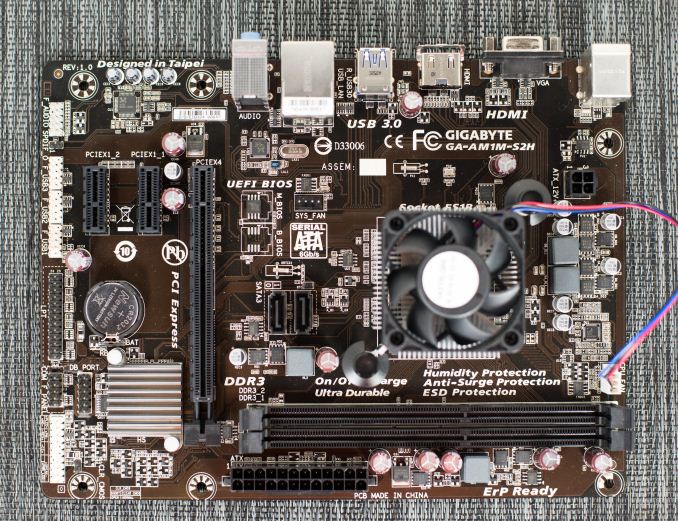
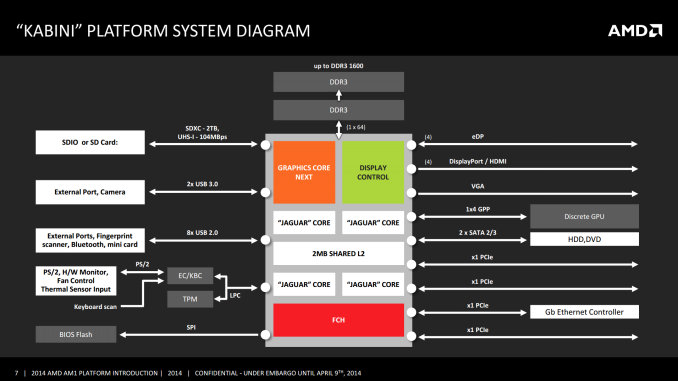
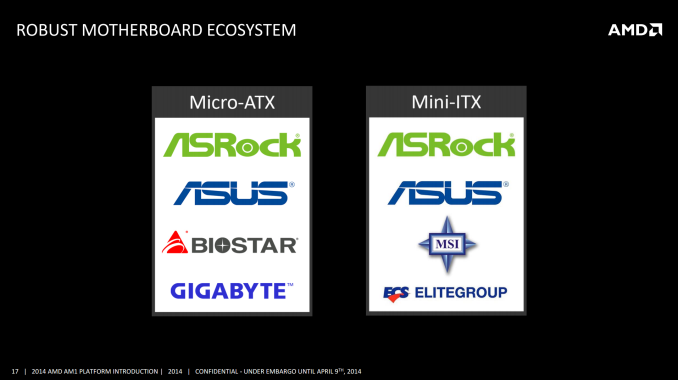
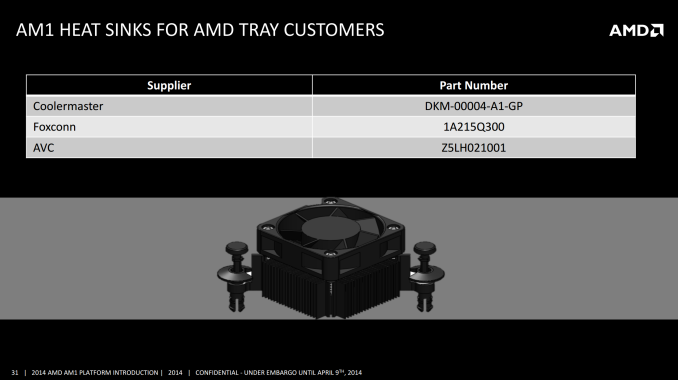
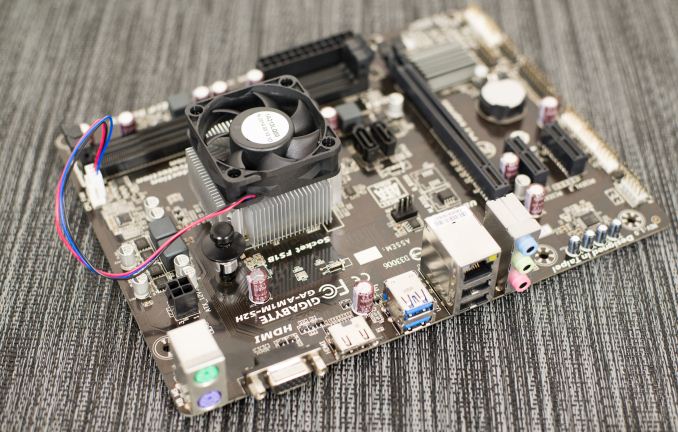
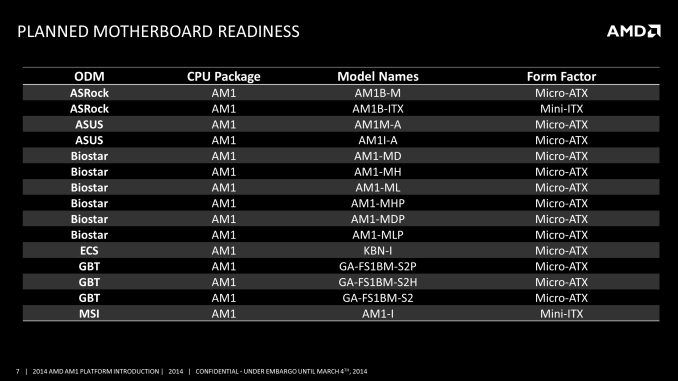








126 Comments
View All Comments
macs - Wednesday, April 9, 2014 - link
I know it's only part one. Anyway it's pretty much useless. I think that on low cost platform like this power consumption for a file server and htpc quality are way more relevant than playing tomb raider or borderlands...DudemanX - Wednesday, April 9, 2014 - link
I don't disagree with any of that but then why have the game benches at all? Even if they just show us how they get unplayably crushed at 1920x1200xHigh quality settings at least we would be able to see how the IGP power is relative to the discrete chips. I'm just wondering for whom these 1280x1024 numbers are for.hero4hire - Saturday, April 12, 2014 - link
Bought a H81 for $60, haswell g1830 Celeron for $30. There were cheap $40 boards available. I'm not sold on this chip as graphics performance are rapidly increasing while cpu not. Why hamstring myself to graphics target in upgrades (socketed) when any $20 graphics "accelerator" will be better. Plus I know have a real upgrade path graphically if needed.azazel1024 - Wednesday, April 9, 2014 - link
For a really cheap, low power system, the AMD Kabinis might work.However, looking at what they offer, they can't replace my server with a lower power version. Only 2 SATA3 slots, which means I'd need to throw a RAID card on there of some sort, even a lot end one would add a lot to the price and a lot more to the power consumption.
My G1610 based system ran $92 for CPU+board ($42 processor, $50 board on sale). It can run rings around even the best Kabini here. Yes, it is 55w versus 25w. That is one of the big things I see missing from this review, was actual power consumption of those Sandy/Ivy celeron systems and the J1800 and the Kabini. What are we talking practical power consumption? I use my server as a file server, itunes server, calibre server and download server. It doesn't need a ton of grunt...but in some use cases, I could see it being bogged down with something like a Kabini (or even the Bay Trail based ones) pretty badly. Like updating iTunes library entries and such forth.
TDP isn't the only story though, idle power consumption is probably lower on the Kabini than mine...but my TOTAL system power consumption is 21w at idle, 33w streaming video and only 51w under max CPU load (with HDD spun up too, which add around 12w of load for them when not parked). So between idle and max, the CPU has only a dW of 20w, and possibly a little less as the network cards are somewhat more active to, which might be accounting for a watt or so there.
I know that the CPU is pretty power efficient at idle, though I am sure it could be better...so the CPU itself might be consuming 6-10w at idle and only hitting maybe 30w max under load.
Now if the board itself that Kabini goes in to can also reduce power consumption a fair amount...
Back to needing a RAID card though....sigh.
I am really hoping that Cherry Trail Pentium and Celeron systems include RAID on the boards and also 4 SATA2 slots (or 1/2 SATA3 and 2/3 SATA2). Might just be a good shot to replace my server with one. Especially if it has onboard dual NICs.
Probably be a Haswell or Broadwell Celeron/Pentium that replaces my server in a year or two though. Sigh.
mrdude - Wednesday, April 9, 2014 - link
You may want to take a look at something like this:http://www.servethehome.com/Server-detail/supermic...
Provided you don't need IPMI, it seems a solid deal for under $180. Twice the cost of the best Kabini combination above, but it's lower power, passively cooled, has dual Intel NICs with 6 SATA ports.
I'd love to see AMD compete in that segment of the market since Kabini has a lot to offer there, but they seem to have completely abandoned the x86 server segment. A Kabini NUC-like form factor would be great to see too if they can maintain the socketability. NUCs are wasteful and idiotic in that you have to throw them away if you want to upgrade. An AM1 SFF with swappable motherboards and SoCs would certainly be interesting.
Shivansps - Wednesday, April 9, 2014 - link
@ NeweggG1820 $54
Asrock H81M-DGS $49
=$103
Athlon 5350+AM1 mb = +/- $90
im sorry, but i dont see why the G1820 is not incluided here... I whant to see that comparison.
YuLeven - Wednesday, April 9, 2014 - link
Because Haswell G1820 would put Kabini's performance to shame and arguments like power comsumption wouldn't cut as excuses to it. Well... that would hurt "AMD Center".jospoortvliet - Thursday, April 10, 2014 - link
Could you keep that nonsense to yourself please?JDG1980 - Wednesday, April 9, 2014 - link
You'll be paying more for the LGA 1150 solution if you want a Mini-ITX form factor. In contrast, AM1 has Mini-ITX boards as low as $35.Torashin - Wednesday, April 9, 2014 - link
"For non-GPU intensive tasks, on paper, the J1900 for $92 and 10W TDP would seem to be the choice if upgradability is not a concern."WHAT????
I'm starting to understand why some people call this place Inteltech. How can you justify what you just said? The CPU with half the power - yeah you're keen to point out they're similar in single threaded, but it has half the core count and it shows - and also more expensive, is somehow the better choice!